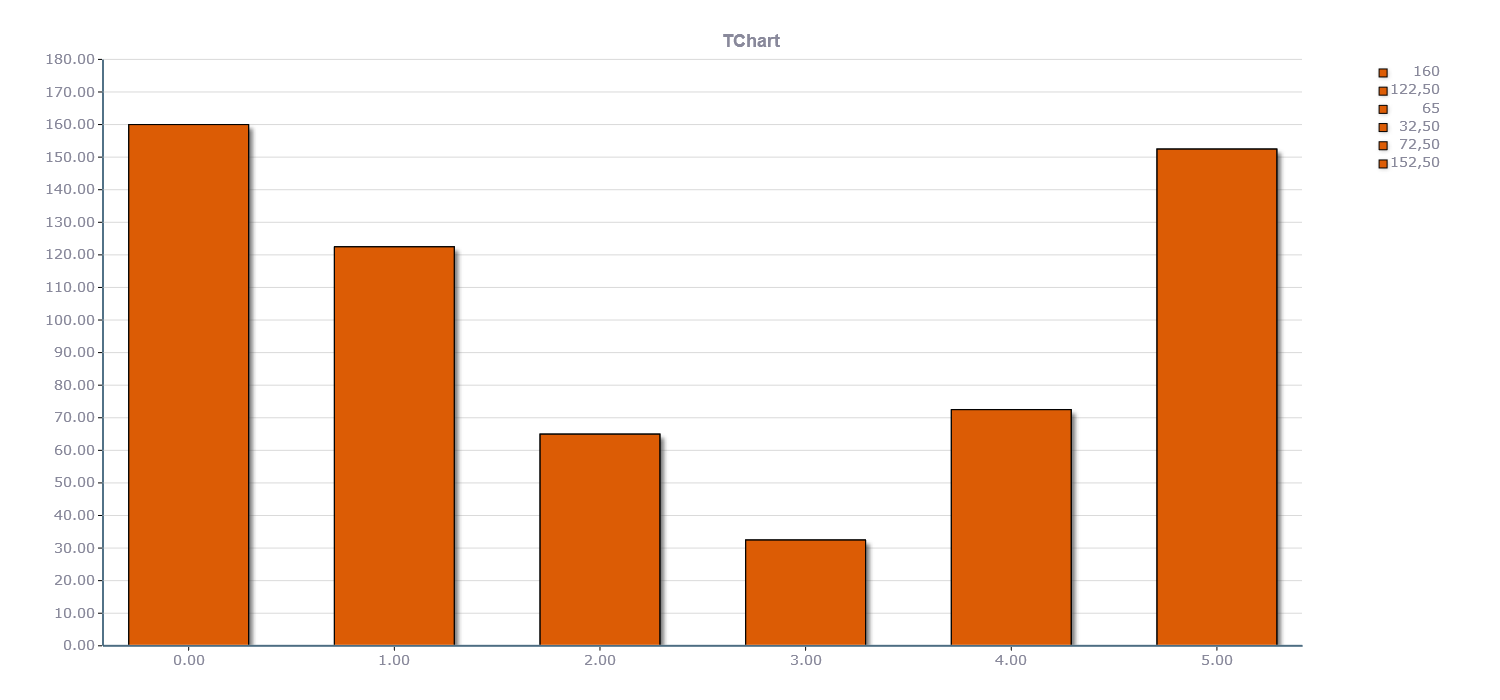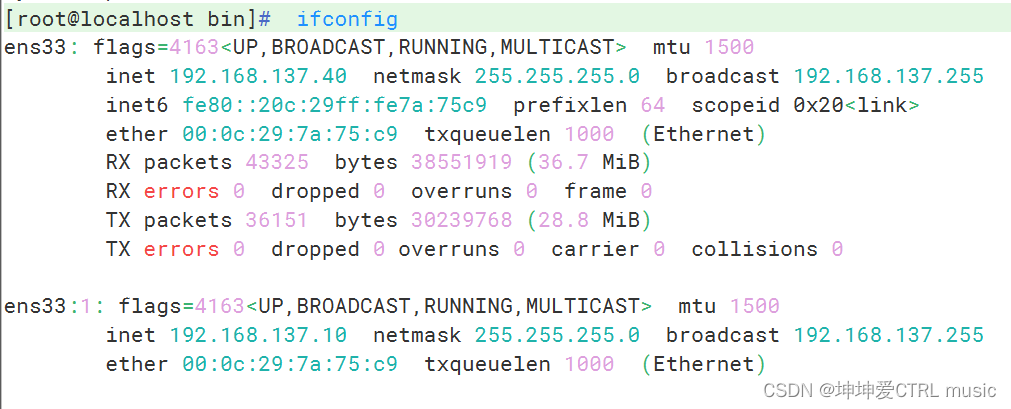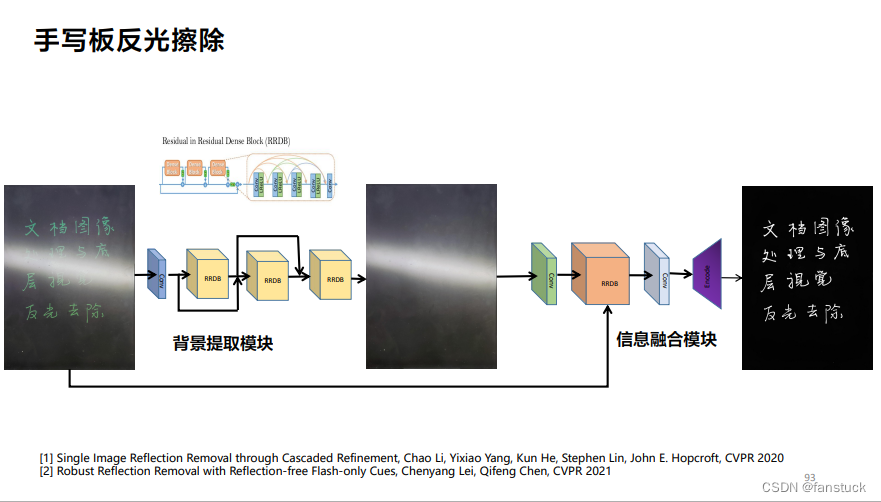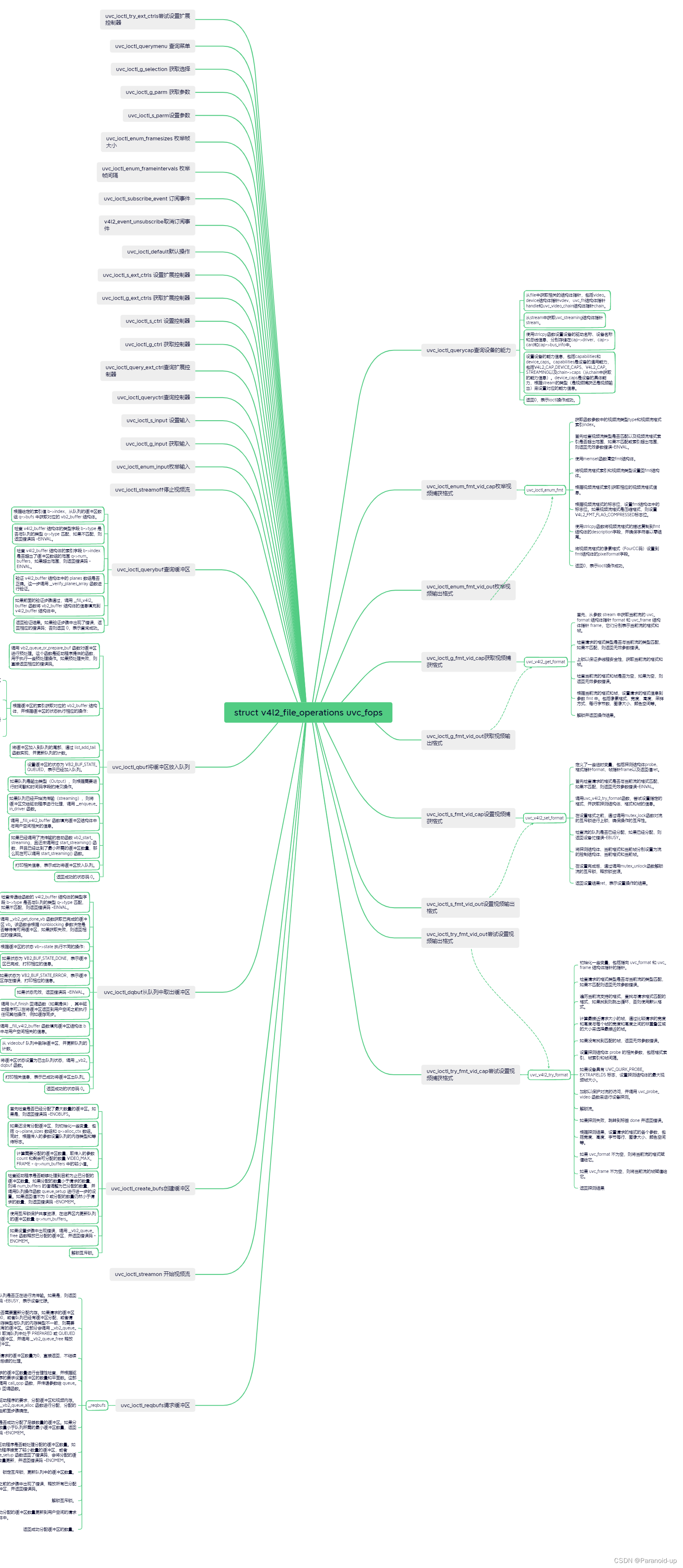第四章 数学知识
初等数论二:https://www.acwing.com/blog/content/26394/
质数
试除法判定质数
bool is_prime(int x)
{
if (x < 2) return false;
for (int i = 2; i <= x / i; i ++ )
if (x % i == 0)
return false;
return true;
}
试除法分解质因数
void divide(int x)
{
for (int i = 2; i <= x / i; i ++ )
if (x % i == 0)
{
int s = 0;
while (x % i == 0) x /= i, s ++ ;
cout << i << ' ' << s << endl;
}
if (x > 1) cout << x << ' ' << 1 << endl; // 大于sqrt(n)的质因数
cout << endl;
}
朴素筛法求素数
// O(nlogn)
// 不论质数和合数均去除i的2 3 4 …倍的数字
int primes[N], cnt; // primes[]存储所有素数
bool st[N]; // st[x]存储x是否被筛掉
void get_primes(int n)
{
for (int i = 2; i <= n; i ++ )
{
if(!st[i]) primes[cnt ++ ] = i;
for (int j = i + i; j <= n; j += i) // 筛掉i的倍数
st[j] = true;
}
}
埃氏筛法求素数
// O(nloglogn)
// 只去除质数的倍数
int primes[N], cnt; // primes[]存储所有素数
bool st[N]; // st[x]存储x是否被筛掉
void get_primes(int n)
{
for (int i = 2; i <= n; i ++ )
{
if(!st[i]){
primes[cnt ++ ] = i;
for (int j = i + i; j <= n; j += i) // 筛掉i的倍数
st[j] = true;
}
}
}
线性筛法求素数
// O(n)
// 每个合数只会被自己的 最小质因子 筛去
int primes[N], cnt; // primes[]存储所有素数
bool st[N]; // st[x]存储x是否被筛掉
void get_primes(int n)
{
for (int i = 2; i <= n; i ++ )
{
if (!st[i]) primes[cnt ++ ] = i;
for (int j = 0; primes[j] <= n / i; j ++ ) // 将i乘以素数序列中的每一个数筛掉
{
st[primes[j] * i] = true;
if (i % primes[j] == 0) break; // 当primes[j]为i的最小质因子时
}
}
}
约数
试除法求所有约数
vector<int> get_divisors(int x)
{
vector<int> res;
for (int i = 1; i <= x / i; i ++ )
if (x % i == 0)
{
res.push_back(i);
if (i != x / i) res.push_back(x / i);
}
sort(res.begin(), res.end());
return res;
}
约数个数和约数之和
// 如果 N = p1^c1 * p2^c2 * ... *pk^ck
// 约数个数: (c1 + 1) * (c2 + 1) * ... * (ck + 1)
// 约数之和: (p1^0 + p1^1 + ... + p1^c1) * ... * (pk^0 + pk^1 + ... + pk^ck)
#include <iostream>
#include <unordered_map>
using namespace std;
const int mod = 1e9 + 7;
typedef long long LL;
unordered_map<int, int> primes;
void get_primes(int x){
for(int i = 2; i <= x / i; i ++)
while(x % i == 0){
x /= i;
primes[i] ++;
}
if(x > 1) primes[x] ++;
}
int main(){
int n, x;
cin >> n;
while(n --){
cin >> x;
get_primes(x);
}
LL res = 1;
// 求个数
for(auto prime : primes) res = res * (prime.second + 1) % mod;
// 求和
for(auto prime : primes){
int p = prime.first, a = prime.second;
LL t = 1;
while(a --) t = (t * p + 1) % mod;
res = res * t % mod;
}
cout << res << endl;
return 0;
}
欧几里得算法(辗转相除法)
int gcd(int a, int b)
{
return b ? gcd(b, a % b) : a;
}
欧拉函数

互质:最大公约数为1,即gcd(a, b) = 1
求欧拉函数
int phi(int x)
{
int res = x;
for (int i = 2; i <= x / i; i ++ )
if (x % i == 0)
{
res = res / i * (i - 1); // 先除后乘,否则溢出
while (x % i == 0) x /= i;
}
if (x > 1) res = res / x * (x - 1);
return res;
}
筛法求欧拉函数
int primes[N], cnt; // primes[]存储所有素数
int euler[N]; // 存储每个数的欧拉函数
bool st[N]; // st[x]存储x是否被筛掉
void get_eulers(int n)
{
euler[1] = 1;
for (int i = 2; i <= n; i ++ )
{
if (!st[i])
{
primes[cnt ++ ] = i;
euler[i] = i - 1;
}
for (int j = 0; primes[j] <= n / i; j ++ )
{
int t = primes[j] * i;
st[t] = true;
if (i % primes[j] == 0)
{
euler[t] = euler[i] * primes[j];
break;
}
euler[t] = euler[i] * (primes[j] - 1);
}
}
}
快速幂
快速幂
求 a^k mod p,时间复杂度 O(logk)。
int qmi(int a, int k, int p)
{
int res = 1;
while (k)
{
if (k & 1) res = (LL)res * a % p;
a = (LL)a * a % p;
k >>= 1;
}
return res;
}
快速幂求逆元
#include <iostream>
#include <algorithm>
using namespace std;
typedef long long LL;
LL qmi(int a, int b, int p)
{
LL res = 1;
while (b)
{
if (b & 1) res = res * a % p;
a = a * (LL)a % p;
b >>= 1;
}
return res;
}
int main()
{
int n;
scanf("%d", &n);
while (n -- )
{
int a, p;
scanf("%d%d", &a, &p);
if (a % p == 0) puts("impossible");
else printf("%lld\n", qmi(a, p - 2, p));
}
return 0;
}
扩展欧几里得算法
![[外链图片转存失败,源站可能有防盗链机制,建议将图片保存下来直接上传(img-VmC9oNwY-1684724736370)(C:\Users\yuemi\AppData\Roaming\Typora\typora-user-images\image-20230419204929610.png)]](https://img-blog.csdnimg.cn/b035cfa3abf343558a6238a95ed33479.png)
// 求x, y,使得ax + by = gcd(a, b)
int exgcd(int a, int b, int &x, int &y)
{
if (!b)
{
x = 1; y = 0;
return a;
}
int d = exgcd(b, a % b, y, x);
y -= a / b * x;
return d;
}
中国剩余定理
![[外链图片转存失败,源站可能有防盗链机制,建议将图片保存下来直接上传(img-y0OWQHzu-1684724736370)(C:\Users\yuemi\AppData\Roaming\Typora\typora-user-images\image-20230422195758343.png)]](https://img-blog.csdnimg.cn/b73c350a36214517a24f4cbce2c7bd30.png)
#include <iostream>
#include <algorithm>
using namespace std;
typedef long long LL;
LL exgcd(LL a, LL b, LL &x, LL &y)
{
if (!b)
{
x = 1, y = 0;
return a;
}
LL d = exgcd(b, a % b, y, x);
y -= a / b * x;
return d;
}
int main()
{
int n;
cin >> n;
LL x = 0, m1, a1;
cin >> m1 >> a1;
for (int i = 0; i < n - 1; i ++ )
{
LL m2, a2;
cin >> m2 >> a2;
LL k1, k2;
LL d = exgcd(m1, m2, k1, k2);
if ((a2 - a1) % d)
{
x = -1;
break;
}
k1 *= (a2 - a1) / d;
k1 = (k1 % (m2/d) + m2/d) % (m2/d);
x = k1 * m1 + a1;
LL m = abs(m1 / d * m2);
a1 = k1 * m1 + a1;
m1 = m;
}
if (x != -1) x = (a1 % m1 + m1) % m1;
cout << x << endl;
return 0;
}
高斯消元
// a[N][N]是增广矩阵
int gauss()
{
int c, r;
for (c = 0, r = 0; c < n; c ++ )
{
int t = r;
for (int i = r; i < n; i ++ ) // 找到绝对值最大的行
if (fabs(a[i][c]) > fabs(a[t][c]))
t = i;
if (fabs(a[t][c]) < eps) continue;
for (int i = c; i <= n; i ++ ) swap(a[t][i], a[r][i]); // 将绝对值最大的行换到最顶端
for (int i = n; i >= c; i -- ) a[r][i] /= a[r][c]; // 将当前行的首位变成1
for (int i = r + 1; i < n; i ++ ) // 用当前行将下面所有的列消成0
if (fabs(a[i][c]) > eps)
for (int j = n; j >= c; j -- )
a[i][j] -= a[r][j] * a[i][c];
r ++ ;
}
if (r < n)
{
for (int i = r; i < n; i ++ )
if (fabs(a[i][n]) > eps)
return 2; // 无解
return 1; // 有无穷多组解
}
for (int i = n - 1; i >= 0; i -- )
for (int j = i + 1; j < n; j ++ )
a[i][n] -= a[i][j] * a[j][n];
return 0; // 有唯一解
}
求组合数
递推法求组合数
O(N^2)
// c[a][b] 表示从a个苹果中选b个的方案数
for (int i = 0; i < N; i ++ )
for (int j = 0; j <= i; j ++ )
if (!j) c[i][j] = 1;
else c[i][j] = (c[i - 1][j] + c[i - 1][j - 1]) % mod;
通过预处理逆元的方式求组合数
O(NlogN)
首先预处理出所有阶乘取模的余数fact[N],以及所有阶乘取模的逆元infact[N]
如果取模的数是质数,可以用费马小定理求逆元
#include <iostream>
using namespace std;
typedef long long LL;
const int N = 100010, mod = 1e9 + 7;
int fact[N], infact[N];
int qmi(int a, int k, int p) // 快速幂模板
{
int res = 1;
while (k)
{
if (k & 1) res = (LL)res * a % p;
a = (LL)a * a % p;
k >>= 1;
}
return res;
}
int main()
{
// 预处理阶乘的余数和阶乘逆元的余数
fact[0] = infact[0] = 1;
for (int i = 1; i < N; i ++ )
{
fact[i] = (LL)fact[i - 1] * i % mod;
infact[i] = (LL)infact[i - 1] * qmi(i, mod - 2, mod) % mod;
}
int n;
scanf("%d", &n);
while (n -- )
{
int a, b;
scanf("%d%d", &a, &b);
printf("%d\n", (LL)fact[a] * infact[b] % mod * infact[a - b] % mod);
}
return 0;
}
Lucas 定理
若p是质数,则对于任意整数 1 <= m <= n,有:
C(n, m) = C(n % p, m % p) * C(n / p, m / p) (mod p)
int qmi(int a, int k){
int res = 1;
while(k){
if(k & 1) res = (LL)res * a % p;
a = (LL)a * a % p;
k >>= 1;
}
return res;
}
int C(int a, int b){ // 定理求C(a, b)
int res = 1;
for(int i = 1, j = a; i <= b; i ++, j --){
res = (LL)res * j % p;
res = (LL)res * qmi(i, p - 2) % p;
}
return res;
}
int lucas(LL a, LL b){
if(a < p && b < p) return C(a, b);
return (LL)C(a % p, b % p) * lucas(a / p, b / p) % p;
}
分解质因数法求组合数
当我们需要求出组合数的真实值,而非对某个数的余数时,分解质因数的方式比较好用:
1. 筛法求出范围内的所有质数
2. 通过 C(a, b) = a! / b! / (a - b)! 这个公式求出每个质因子的次数。 n!中p的次数是 n / p + n / p^2 + n / p^3 + ...
3. 用高精度乘法将所有质因子相乘
int primes[N], cnt; // 存储所有质数
int sum[N]; // 存储每个质数的次数
bool st[N]; // 存储每个数是否已被筛掉
void get_primes(int n) // 线性筛法求素数
{
for (int i = 2; i <= n; i ++ )
{
if (!st[i]) primes[cnt ++ ] = i;
for (int j = 0; primes[j] <= n / i; j ++ )
{
st[primes[j] * i] = true;
if (i % primes[j] == 0) break;
}
}
}
int get(int n, int p) // 求n!中的次数
{
int res = 0;
while (n)
{
res += n / p;
n /= p;
}
return res;
}
vector<int> mul(vector<int> &A, int b) // 高精度乘低精度模板
{
vector<int> C;
int t = 0;
for(int i = 0; i < A.size() || t; i ++){
if(i < A.size()) t += A[i] * b;
C.push_back(t % 10);
t /= 10;
}
return C;
}
get_primes(a); // 预处理范围内的所有质数
for (int i = 0; i < cnt; i ++ ) // 求每个质因数的次数
{
int p = primes[i];
sum[i] = get(a, p) - get(b, p) - get(a - b, p);
}
vector<int> res;
res.push_back(1);
for (int i = 0; i < cnt; i ++ ) // 用高精度乘法将所有质因子相乘
for (int j = 0; j < sum[i]; j ++ )
res = mul(res, primes[i]);
卡特兰数
给定n个0和n个1,它们按照某种顺序排成长度为2n的序列,满足任意前缀中0的个数都不少于1的个数的序列的数量为: Cat(n) = C(2n, n) / (n + 1)
// 满足条件的01序列
#include <iostream>
#include <algorithm>
using namespace std;
typedef long long LL;
const int N = 100010, mod = 1e9 + 7;
int qmi(int a, int k, int p)
{
int res = 1;
while (k)
{
if (k & 1) res = (LL)res * a % p;
a = (LL)a * a % p;
k >>= 1;
}
return res;
}
int main()
{
int n;
cin >> n;
int a = n * 2, b = n;
int res = 1;
for (int i = a; i > a - b; i -- ) res = (LL)res * i % mod;
for (int i = 1; i <= b; i ++ ) res = (LL)res * qmi(i, mod - 2, mod) % mod;
res = (LL)res * qmi(n + 1, mod - 2, mod) % mod;
cout << res << endl;
return 0;
}
容斥原理
2^20 = 106,1秒计算107-10^8次
#include <iostream>
#include <algorithm>
using namespace std;
typedef long long LL;
const int N = 20;
int p[N];
int main()
{
int n, m;
cin >> n >> m;
for (int i = 0; i < m; i ++ ) cin >> p[i];
int res = 0;
for (int i = 1; i < 1 << m; i ++ )
{
int t = 1, s = 0;
for (int j = 0; j < m; j ++ )
if (i >> j & 1)
{
if ((LL)t * p[j] > n)
{
t = -1;
break;
}
t *= p[j];
s ++ ;
}
if (t != -1)
{
if (s % 2) res += n / t;
else res -= n / t;
}
}
cout << res << endl;
return 0;
}
博弈论
Nim 游戏
给定N堆物品,第i堆物品有Ai个。两名玩家轮流行动,每次可以任选一堆,取走任意多个物品,可把一堆取光,但不能不取。取走最后一件物品者获胜。两人都采取最优策略,问先手是否必胜。
我们把这种游戏称为NIM博弈。把游戏过程中面临的状态称为局面。整局游戏第一个行动的称为先手,第二个行动的称为后手。若在某一局面下无论采取何种行动,都会输掉游戏,则称该局面必败。
所谓采取最优策略是指,若在某一局面下存在某种行动,使得行动后对面面临必败局面,则优先采取该行动。同时,这样的局面被称为必胜。我们讨论的博弈问题一般都只考虑理想情况,即两人均无失误,都采取最优策略行动时游戏的结果。
NIM博弈不存在平局,只有先手必胜和先手必败两种情况。
定理: NIM博弈先手必胜,当且仅当 A1 ^ A2 ^ … ^ An != 0
公平组合游戏ICG
若一个游戏满足:
由两名玩家交替行动;
在游戏进程的任意时刻,可以执行的合法行动与轮到哪名玩家无关;
不能行动的玩家判负;
则称该游戏为一个公平组合游戏。
NIM博弈属于公平组合游戏,但城建的棋类游戏,比如围棋,就不是公平组合游戏。因为围棋交战双方分别只能落黑子和白子,胜负判定也比较复杂,不满足条件2和条件3。
有向图游戏
给定一个有向无环图,图中有一个唯一的起点,在起点上放有一枚棋子。两名玩家交替地把这枚棋子沿有向边进行移动,每次可以移动一步,无法移动者判负。该游戏被称为有向图游戏。
任何一个公平组合游戏都可以转化为有向图游戏。具体方法是,把每个局面看成图中的一个节点,并且从每个局面向沿着合法行动能够到达的下一个局面连有向边。
Mex运算
设S表示一个非负整数集合。定义mex(S)为求出不属于集合S的最小非负整数的运算,即:mex(S) = min{x}, x属于自然数,且x不属于S
SG函数
在有向图游戏中,对于每个节点x,设从x出发共有k条有向边,分别到达节点y1, y2, …, yk,定义SG(x)为x的后继节点y1, y2, …, yk 的SG函数值构成的集合再执行mex(S)运算的结果,即:SG(x) = mex({SG(y1), SG(y2), …, SG(yk)})。特别地,整个有向图游戏G的SG函数值被定义为有向图游戏起点s的SG函数值,即SG(G) = SG(s)。
有向图游戏的和
设G1, G2, …, Gm 是m个有向图游戏。定义有向图游戏G,它的行动规则是任选某个有向图游戏Gi,并在Gi上行动一步。G被称为有向图游戏G1, G2, …, Gm的和。有向图游戏的和的SG函数值等于它包含的各个子游戏SG函数值的异或和,即:SG(G) = SG(G1) ^ SG(G2) ^ … ^ SG(Gm)
定理
有向图游戏的某个局面必胜,当且仅当该局面对应节点的SG函数值大于0。
有向图游戏的某个局面必败,当且仅当该局面对应节点的SG函数值等于0。
常规-Nim游戏
#include <iostream>
using namespace std;
const int N = 100010;
int main()
{
int n;
scanf("%d", &n);
int res = 0;
while (n --)
{
int x;
scanf("%d", &x);
res ^= x;
}
if (res) puts("Yes");
else puts("No");
return 0;
}
台阶-Nim游戏
#include <iostream>
#include <algorithm>
using namespace std;
const int N = 100010;
int main()
{
int n;
scanf("%d", &n);
int res = 0;
for (int i = 1; i <= n; i ++ )
{
int x;
scanf("%d", &x);
if (i & 1) res ^= x;
}
if (res) puts("Yes");
else puts("No");
return 0;
}
集合-Nim游戏
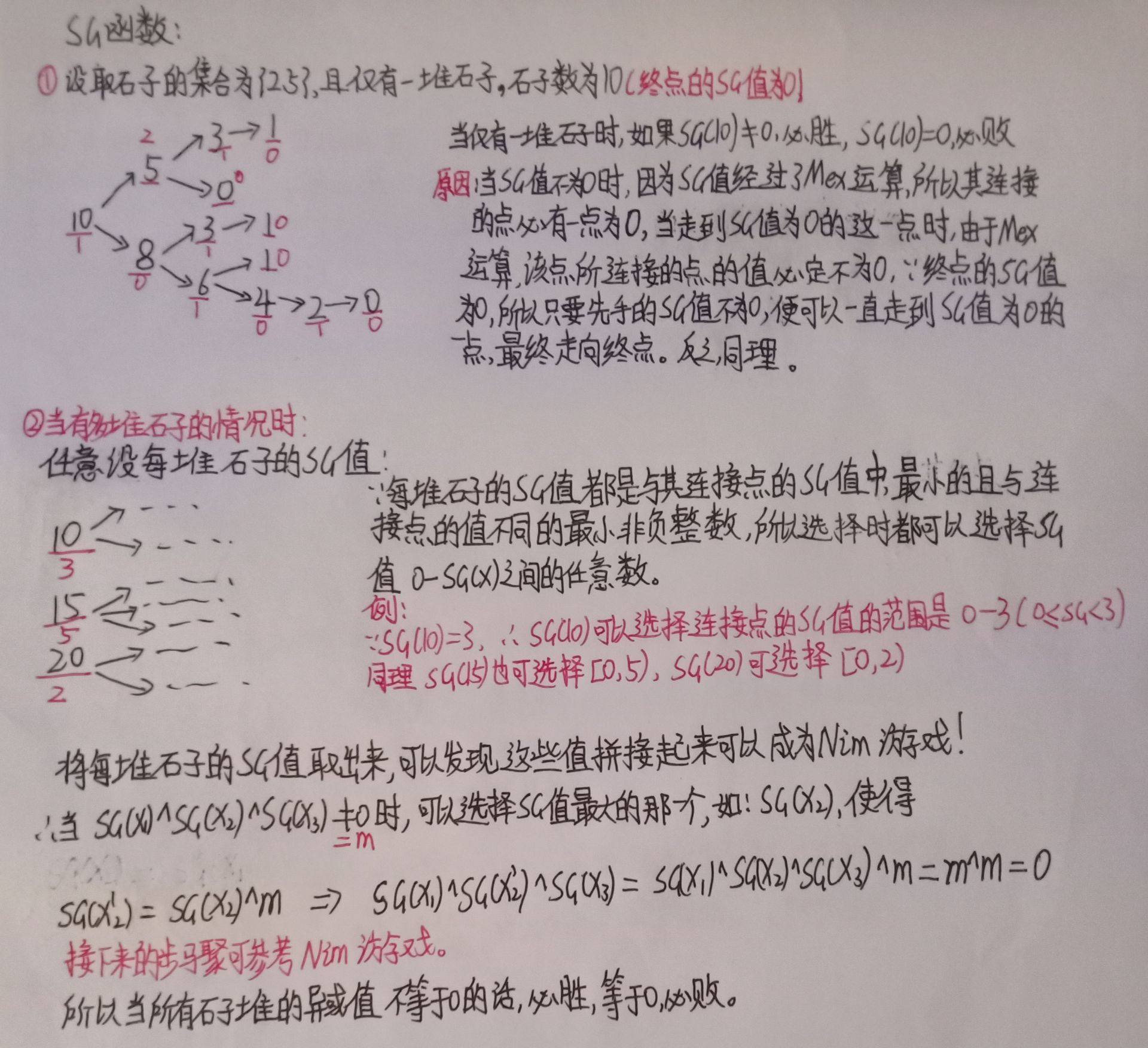
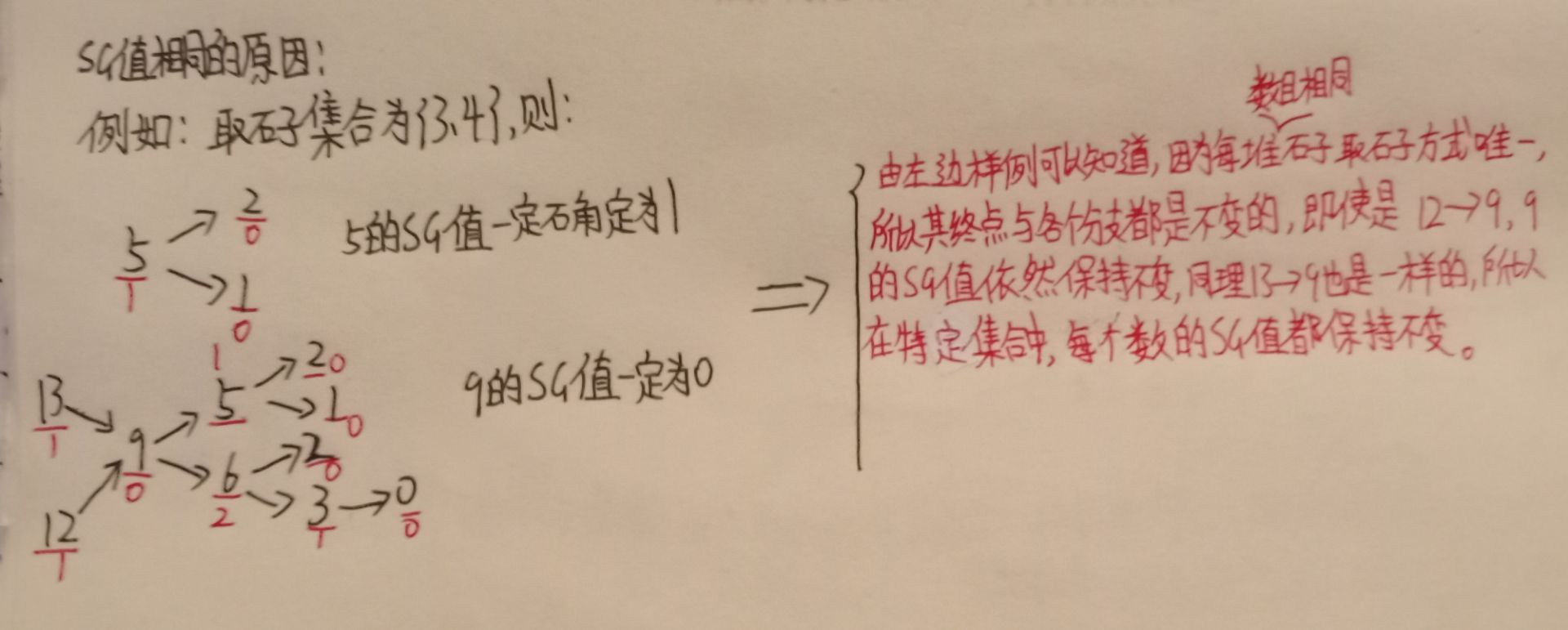
#include <cstring>
#include <iostream>
#include <algorithm>
#include <unordered_set>
using namespace std;
const int N = 110, M = 10010;
int n, m;
int s[N], f[M];
int sg(int x)
{
if (f[x] != -1) return f[x];
// 局部变量的递归
unordered_set<int> S;
for (int i = 0; i < m; i ++ )
{
int sum = s[i];
if (x >= sum) S.insert(sg(x - sum));
}
for (int i = 0; ; i ++ )
if (!S.count(i))
return f[x] = i;
}
int main()
{
cin >> m;
for (int i = 0; i < m; i ++ ) cin >> s[i];
cin >> n;
memset(f, -1, sizeof f);
int res = 0;
for (int i = 0; i < n; i ++ )
{
int x;
cin >> x;
res ^= sg(x);
}
if (res) puts("Yes");
else puts("No");
return 0;
}
拆分-Nim游戏
#include <cstring>
#include <iostream>
#include <algorithm>
#include <unordered_set>
using namespace std;
const int N = 110;
int n;
int f[N];
int sg(int x)
{
if (f[x] != -1) return f[x];
unordered_set<int> S;
for (int i = 0; i < x; i ++ )
for (int j = 0; j <= i; j ++ )
S.insert(sg(i) ^ sg(j));
for (int i = 0;; i ++ )
if (!S.count(i))
return f[x] = i;
}
int main()
{
cin >> n;
memset(f, -1, sizeof f);
int res = 0;
while (n -- )
{
int x;
cin >> x;
res ^= sg(x);
}
if (res) puts("Yes");
else puts("No");
return 0;
}



